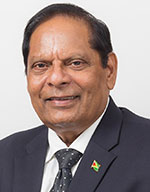AT year-end, the popular verdict of the Guyanese people is that their government in 2017 continued to deliver in response to growing expectations. That was the message that grassroots folks conveyed directly to their leaders as they walked the streets, visited their villages and grounded with them, especially during this season of goodwill.
The revolutionary situation that had propelled the removal of the former corrupt regime continues to push the process of change. That change has been weaving patterns of progress in Guyana since May 2015. It signifies a radical break from the old politics of one-party rule and ushered in a silent, peaceful but dynamic revolution under the APNU+AFC Coalition Government.
ECONOMIC PERFORMANCE
It is important to look at the backdrop of what was, in order to appreciate what is really happening in Guyana today. By 2014, when the spectre of authoritarian rule had cast a dark shadow over Guyana, direct private investment had started to slow down. Guyana was denied strategic funds from the international community because of fears that there was no accountability under the former regime. By then, the sugar industry was grounded by bankruptcy and the rice market was sabotaged by the then Petro-Caribe partners. Notwithstanding the signs of paralysis, economic growth under the new government was maintained at an average of 3 percent.
It must be a herculean task to therefore maintain by the end of 2017, the level of social benefits much less to actually increase the minimum wage by over 50 percent and to extend concessions to areas such as the income tax rate and the income tax threshold, to give working people more disposable incomes. This year, the wages of public servants went up by up to 8 percent, while the monthly minimum wage was increased to $ 60,000! Old Age pensions were increased by almost 45 percent. Some 50,000 senior citizens benefit from the modest increase. Socially vulnerable persons saw a 27% increase in their allowance.
BUSINESS CONCESSIONS
In the business sector, manufacturing and non-commercial companies saw a reduction of the corporate tax rate from 30 percent to 27.5 percent; reduction of the Value-Added Tax (VAT) from 16 to 14 percent, and an increase of the VAT threshold from $10M to $15M. The latter freed many small businesses from cumbersome paperwork.
These concessions and those new ones for 2018 for the mining and logging sectors, have fortified the partnership tripod of the state, labour and business. Agro-business was given a boost with rehabilitation of major farm-to-market roads, and mega pumps were installed in the main agricultural regions.
Hinterland agriculture was not neglected. Efforts were made to promote crop diversification with cultivation of spices in the Barima-Waini region, promotion of tomato-processing in the Potaro-Siparuni region, and help for cashew and peanut production in the Rupununi.
I have catalogued the above from reports by the Finance Ministry to rebut the contention by the handful of politicians who try to mislead our people with propaganda that the economy is at a standstill. But the empirical evidence is overwhelming.
It shows that the Guyana Office for Investment (GOINVEST) has facilitated in just over two years, 240 investment projects valued at G$187 Billion. Both investors and tourists continue to see Guyana as an attractive destination. The tourism sector has reported a 14 percent increase in tourist arrivals. With new internal, regional airports coming on stream, and the international airport upgraded, Guyana is set to be a key hub for cross-continent and regional travels.
PATTERNS OF PROGRESS
These patterns of progress are also evident in the mushrooming of small businesses to which some 2,727 loans and grants have been issued, valued at more than $825M.
Further, two new business incubators are being developed at Belvedere in the East Berbice-Corentyne region and Lethem in the Rupununi, at a cost of G$263M.
SILENT REVOLUTION
The silent revolution has taken a qualitative leap with the distribution of 9,000 laptop computers under the “One Laptop per Teacher” programme, which was launched on World Teachers’ Day on 5th October, 2016.
We have literally come of age with all 112 secondary schools in Guyana being equipped with computer laboratories with access to the internet. Tablets have been distributed to over 2,000 students and 109 teachers in pilot schools.
Under this ICT outreach, many communities and schools in remote, hinterland areas have been provided with free internet access including Aishalton, Annai, Bartica, Bamia, Baramita Iwokrama, Lethem, Linden, Mabaruma, Mahdia, Masekenari, Matthew’s Ridge, Orealla, Paramakatoi, Port Kaituma, Santa Rosa and Waramadong.
In addition, some 53 ICT community hubs have been established across the country.
GOVERNMENT KEPT MOMENTUM
Look at this score-sheet and even the acid cynic would be convinced that this government has not been idle. It has been working for the people and has kept the momentum going from Day One.
* More than 30 hinterland aerodromes were rehabilitated and maintained.
* The four-lane extension of the East Bank Demerara Public Road was completed.
* Village roads, over (100 km), have been constructed or repaired, including at Leguan, Lusignan and Victoria.
* The country’s first pedestrian overpasses have been installed across the East Bank Demerara Public Road.
* The new capital towns and other hinterland communities have benefitted from the repair of over 800 km of roads.
* Rehabilitation of the Vreed-en-Hoop to Parika road is nearing completion.
* Urban roads, extending over 58.3 km in Georgetown and the capital towns of Linden and New Amsterdam, were repaired.
SAFE DRINKING WATER
But for the sceptics I wish to underline the self-evident, that 40 communities have been provided safe drinking water for the first time. This reinforces my contention that this revolution has a sincere social content, which is further manifested by the humane Five Bs initiative by President David Granger.
Under this drive, our children have been provided some 21 school buses, 10 school boats and hundreds of bicycles. In addition, pupils get boots and bags. They also get breakfast, since the hot meals programme was extended from 110 to 172 schools, and serve over 23,000 students.
NEW TOWNS, NEW RADIOS
A wave of pride has swept through Guyana with the establishment of three new towns – the Bartica, Lethem and Mabaruma townships. For the first time ever, the state has provided not only renewable energy supplies and upgraded roads, but radio and television services to these towns as well as in the mining town, Mahdia. As I write, Aishalton has gone on air and soon both radio and television signals would be extended to Moruca and Orealla.
2017 was a challenging year. We faced a massive fire/jail-break; floods in the interior and on the coast; heightened vigilance over our border security, further worsening of the industrial situation in the sugar belt, and a rearguard, runaway and divisive opposition.
But it was a year also of resolute leadership and decisive decisions. Guyana did well. We were on the move? Yes. The Revolution continues!
December 31, 2017



.jpg)








